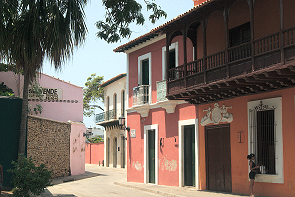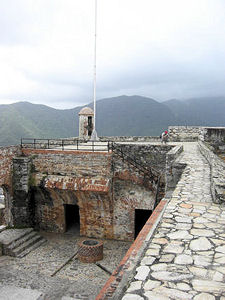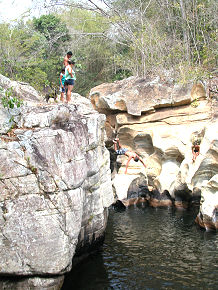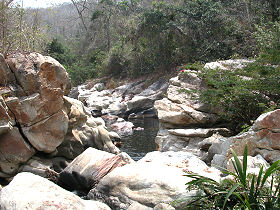| Excursion to paradise
This trip takes us to a small river
flowing in lush tropical surroundings, just three kilometers
from Casa Maria. The centre of attraction of this outing is
a gigantic rubber tree actually within walking distance of
the House. Ornithologists and entomologists will also find
plenty to interest them on this walk. |
| Quebrada Agua Clara,
'Clearwater Stream'
This trip, which can be extended to a
full day, takes us to a small river in a lowland jungle
region, some 300 m above sea level at about 25 km from the
House; it is easily reached in an off-the-road vehicle. The
area is home to lots of birds, insects and items of botanic
interest, not to speak of the fresh-water fish; there are
idyllic waterfalls and crystal clear bathing pools along the
way. |
| The Cloud -- or Rain
-- Forest of Palmichal
The trip leads us into a small and
almost unknown cloud-forest about 1.000mt above sea-level,
only 5 km away from CASA MARIA. The flora and fauna are
typical of those of the Henri Pittier national park, though
happily bereft of any disturbing traffic or people. These
woods cover an area of some 11.000 hectares, being just over
27,000 acres, and can be crossed by a 12-km footpath: if
you're nature-friendly, you will enjoy this outing,
especially as CASA MARIA is within walking distance. |
| |
Cloud-forest of Palmichal |
|
Endemic palm and und endemic
bromeliads |
|
Common mood in the
cloud-forest. |
|
| The San Pablo Marshes
This is a particularly
beautiful trip, especially for spotting rare
birds towards evening; we take a telescope along
with this in mind. One can never predict the
outcome of these excursions but we expect to see
parrots, horned screamers and many other birds
and animals native to these sea-level wetlands.
Travel time from Casa Maria is about 45 minutes. |
| |
Horned screamers |
|
Early evening |
|
|
|
| These are only four
suggestions for half-day excursions. We have others,
for instance to the San Isidro mountains at 1700 m
elevation, to Mt. Marquero and to Mt. La Copa.
Ornithologists will also find it worthwhile to visit
the dry shrub area around the artificial lake at
Canoabo. |
| Full-Day Trips
For our full-day options, we leave Casa
Maria early and get back towards evening. We take packed
lunches and picnic in unparalleled natural settings. |
| Tour to the Caribbean
This tour ranks among visitors'
favorites. From Casa Maria, it takes an hour and a half to
get to the Morrocoy National Park on the coast. We either
take our own boat or rent one on arrival. Once in the park,
we can explore a whole labyrinth of islands and mangroves
and fantastic Caribbean beaches with beautifully clear water
at around 30°C. The day's activities can include snorkeling,
swimming or just indulging in a little dolce fa niente. At
day's end, we make a side trip to the Cuare bird
reservation, well known for its large flamingo colony of
some 20,000 birds. For Casa Maria guests who are so
inclined, the whole outing can be centered on the Cuare
reservation.
If desired, you can do also a
full-day-trip into the bird's reservation. |
| |
Ibises in the Cuare Reservation |
|
No comments :-) |
|
Flamingo-dependencies |
|
| Tour to Puerto
Cabello and the San Estéban National Park.
This trip takes us to the port
of Puerto Cabello with its historic town centre,
still much as it was in colonial times. The next
stop is an old English fort and a visit to a German
cemetery, evidence of the substantial German
immigration in the 19th Century. Nearby, we can
visit the San Estéban National Park where one can
hike and bathe in poetic jungle waterfalls. |
| |
 |
|
|
|
 |
|
| |
Colonial area of Puerto Cabello. |
|
|
|
The old English fortress in Puerto Cabello. |
|
| Tour to the Rio
Capita Valley
This tour is by jeep to
an isolated valley where folk still live almost
as though in colonial times. The rivers are wild
and romantic and there are numerous bathing and
hiking possibilities not to speak of myriad
settings for taking photos. |
| |
 |
|
xxx |
|
 |
|
| |
Canyon landscape |
|
|
|
Rio Capita |
|
| Tour to the city of Coro (4 hours
away from CASA MARIA)
This tour takes us to a landscape very different from that
of the Casa Maria itself: there are salt lakes, giant cacti,
and the famous Coro 'medanos' or sand dunes, if anything,
evocative of a Saharan landscape. Coro itself used to be the
capital of the then Spanish Province of Venezuela and still
has many old buildings of such historical interest that it
has been declared a UNESCO World Heritage site.
The Coro excursion takes in the very arid Paraguaná
Peninsula with its cactus desert; we also spend time in the
town of Punto Fijo, a free port with duty-free shopping. |
|
Coro with the old square and church. |
|
The dunes of Coro |
|
Old colonial buildings with the typical
balconies and cobblestone pavement. |
|
Landscape on the Paraguaná peninsula. |
|
Village on the Paraguaná peninsula. |
|
Salt lake on Paraguaná |
| This tour can be extended to
include a trip into the "Sierra San Luís", the San Luis
Range which is an isolated mountain area with cloud forest
and very interesting bird and insect life. The return
journey can take a swing through the town of Barquisimeto
and even the Yacambú National Park. Given the range of
options and guests' preferences, this tour can take from one
to four days. |
| Los Roques
A trip of a completely different kind
takes us to the offshore Los Roques coral atoll. We drive
early to Valencia airport and take a small 5-seater airplane
to the Main Island where we set off in a small boat to
another island for snorkeling and bathing. The flight alone
is quite an experience. We return to Casa Maria the same
evening.
The actual price for this tour must be negotiated with the
pilot. At present (April 2005) it's approximately 150
dollars per person, including food, boat travel, flight and
snorkel equipment. |
| |
Arrival at Gran Roque. |
|
Our plane |
|
Beach on Los Roques |
|
| Excursion to the Colonia
Tovar
The Colonia Tovar, located high in the
coastal mountain range, was founded in 1843 by 200 German
immigrants from the Germany’s Schwarzwald, the Black Forest.
The settlement was virtually forgotten until the well into
the twentieth century when a road to Caracas was built,
putting the Colonia on the map. Today, the village is an
interesting tourist attraction, preserving as it does, many
old German ways and even the nineteenth century Schwarzwald
dialect spoken by the original colonists and, long since
vanished in Germany itself. Nearby, there is the Pico
Codazzi National Park at 2000mt, about 6500 ft, above sea
level with a wealth of items of zoological and botanic
interest. |
| |
The city gate of Colonia Tovar. |
|
The Black Forest Hotel. |
|
| There are other day-trip
options, taking in the Henri Pittier National Park,
the Hacienda Santa Clara, this last being an old
coffee plantation with lots of big trees and a
waterfall of particular beauty, the San Carlos River
area, of special interest to entomologists, and the
Sierra de Aróa, the “Aróa Range”, with its extremely
damp rain forest. |
| |
Rio San Carlos |
|
Waterfall at Hacienda Santa Clara |
|
Giganthera trees in the Henri
Pittier national-park. |
|
| |
|
Lianas in the cloud-forest of Aróa |
|
|
|